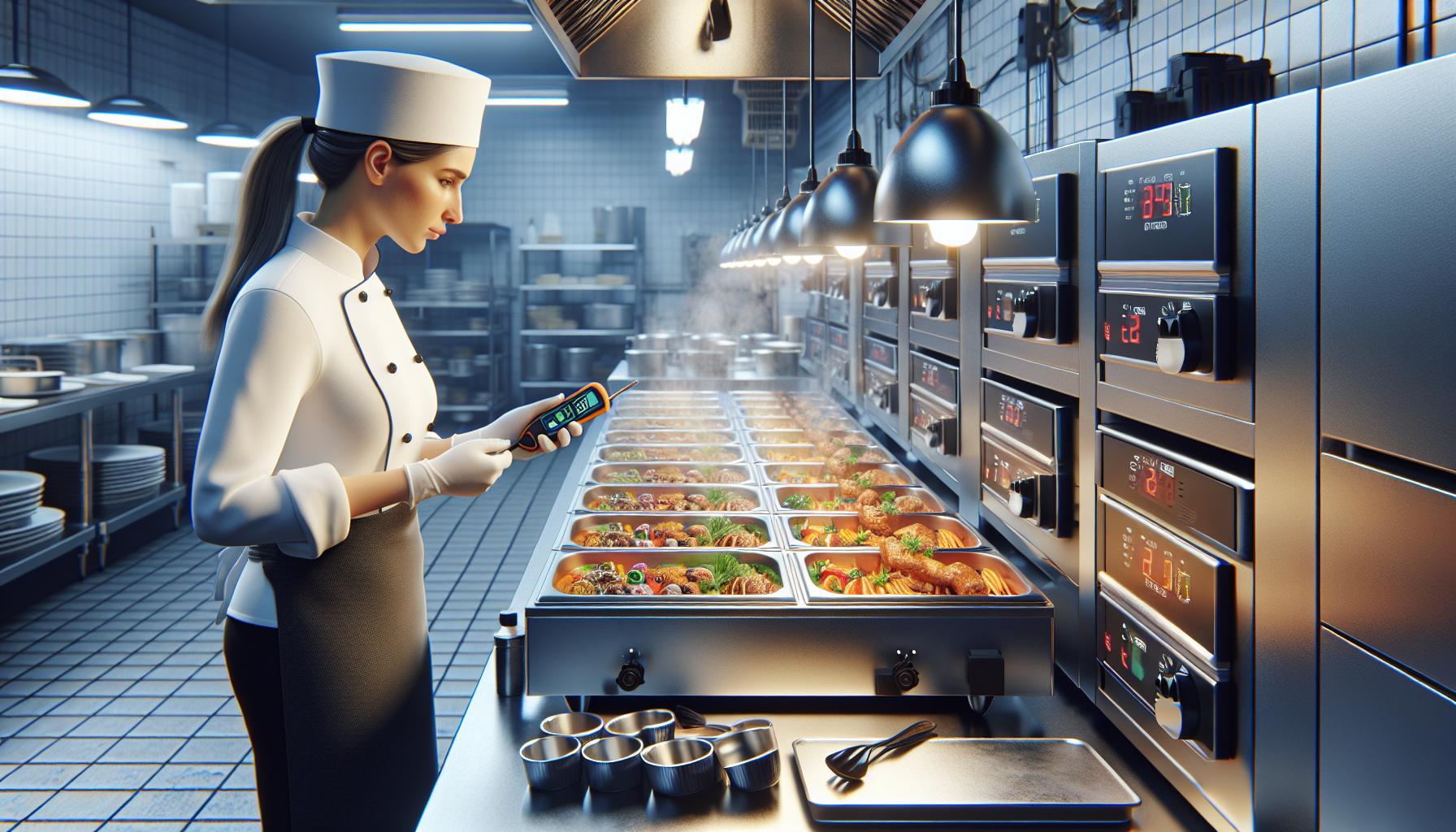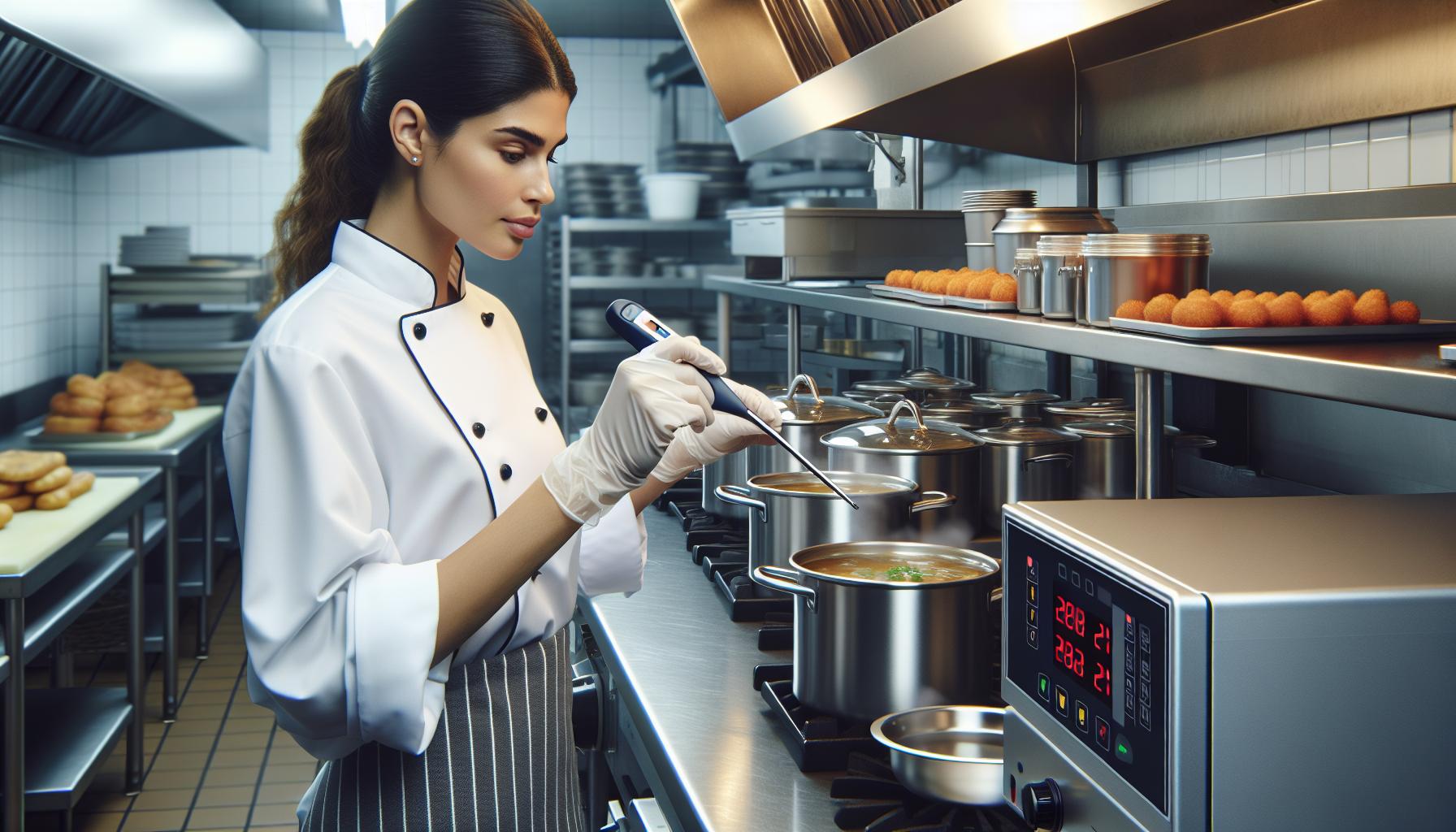Food safety isn’t just about cooking – it’s about keeping those tasty morsels at the right temperature until they’re ready to be devoured. Hot holding temperature control stands as a crucial defense line against foodborne illness, making the difference between a delightful dining experience and an unfortunate trip to the doctor.
When it comes to how hot do you need to hot hold temperature control for safety food, temperature isn’t just a number – it’s a safety shield. Professional kitchens and food service establishments must follow specific guidelines to ensure their hot foods remain in the safe zone. These requirements aren’t arbitrary rules but scientifically proven standards that keep harmful bacteria at bay and protect public health.
How Hot do you Need to Hot Hold Temperature Control for Safety Food
How hot do you need to hot hold temperature control for safety food, Hot holding temperatures protect food from bacterial growth and ensure safe consumption in food service operations. Specific temperature requirements established by the FDA and USDA create a framework for maintaining food safety standards in commercial kitchens.
Minimum Safe Temperature Standards
How hot do you need to hot hold temperature control for safety food:
The FDA mandates a minimum hot holding temperature of 135°F (57°C) for all ready-to-serve hot foods. Different food categories require specific holding temperatures:
| Food Type | Minimum Hot Holding Temperature |
|---|---|
| Poultry | 165°F (74°C) |
| Ground Meat | 155°F (68°C) |
| Whole Cuts of Meat | 145°F (63°C) |
| Hot Vegetables | 135°F (57°C) |
| Soups & Sauces | 135°F (57°C) |
Commercial food warmers maintain these temperatures through:
- Calibrated temperature controls
- Built-in thermometers
- Steam tables with water baths
- Infrared heat lamps
Time and Temperature Danger Zone
The temperature danger zone spans from 40°F to 140°F (4°C to 60°C), where bacteria multiply rapidly. Food left in this range for more than 4 hours becomes unsafe for consumption. Critical control points include:
| Temperature Range | Risk Level | Time Limit |
|---|---|---|
| 40-70°F (4-21°C) | Moderate | 2 hours |
| 70-140°F (21-60°C) | High | 1 hour |
| Above 140°F (60°C) | Safe | Extended periods |
- Temperature checks every 2 hours
- Digital probe thermometer use
- Temperature logs maintenance
- Immediate corrective actions for violations
Proper Hot Holding Equipment and Tools

Commercial kitchens rely on specialized equipment to maintain safe food temperatures during service periods. These tools ensure how hot do you need to hot hold temperature control for safety food control while preserving food quality.
Steam Tables and Warming Units
Steam tables form the backbone of hot food service operations by maintaining temperatures through water-bath heating systems. Commercial food warmers use electrical heating elements or steam to keep food at 135°F (57°C) or above. Modern warming units feature digital controls adjustable heating zones temperature displays to accommodate different food types. Electric buffet warmers come with removable water pans thermostatic controls stainless steel construction for durability. Countertop food warmers provide flexible solutions for smaller operations mobile food service.
Temperature Monitoring Devices
Digital thermometers provide instant temperature readings through infrared or probe sensors for accurate food monitoring. Wireless temperature monitoring systems enable continuous tracking with programmable alerts for temperature violations. Kitchen staff use calibrated probe thermometers to check internal food temperatures at 4-hour intervals. Temperature data loggers record readings automatically creating documentation for food safety compliance. Advanced monitoring devices integrate with kitchen management systems to track temperature trends identify potential issues before they become critical.
| Equipment Type | Temperature Range | Monitoring Frequency |
|---|---|---|
| Steam Tables | 135°F-165°F (57°C-74°C) | Every 2 hours |
| Warming Units | 135°F-200°F (57°C-93°C) | Every 2 hours |
| Digital Thermometers | -58°F-572°F (-50°C-300°C) | Per use |
| Data Loggers | -40°F-185°F (-40°C-85°C) | Continuous |
Hot Holding Best Practices for Different Food Types

Different food categories require specific hot holding temperatures to maintain safety and quality. The following guidelines ensure proper temperature control for various food types in commercial kitchens.
Meat and Poultry Items
Hot holding practices for meat and poultry focus on maintaining safe temperatures throughout service periods. Poultry items demand a minimum internal temperature of 165°F (74°C) during hot holding. Ground beef sits at 155°F (68°C) for optimal safety. Whole cuts of beef remain safe at 145°F (63°C) when held in commercial warmers. Temperature monitoring occurs at 2-hour intervals using calibrated probes inserted into the thickest part of the meat. Steam tables maintain these temperatures through consistent water bath levels at 180°F (82°C). Food service operations store carved meats in shallow pans to ensure even heat distribution.
Soups and Sauces
Soups and sauces require constant temperature monitoring to prevent bacterial growth. These liquid-based foods maintain a minimum temperature of 135°F (57°C) in commercial soup warmers. Stirring occurs every 30 minutes to distribute heat evenly throughout the product. Thick sauces benefit from frequent temperature checks due to their density. Steam table wells hold soup containers at proper depths to ensure adequate heat transfer. Digital temperature displays provide accurate readings for staff monitoring. Ladles remain stored above the food line in dedicated holders to prevent contamination. Commercial kitchens use covered containers to maintain consistent temperatures during service periods.
Common Hot Holding Temperature Mistakes to Avoid

Operating equipment at incorrect temperatures creates significant food safety risks. Here are the critical mistakes that compromise hot holding safety:
- Inaccurate Temperature Monitoring
- Using uncalibrated thermometers
- Taking readings from equipment displays instead of food core temperatures
- Checking temperatures less frequently than every 2 hours
- Equipment Misuse
- Overloading warming units beyond their capacity
- Leaving food warmers open for extended periods
- Operating steam tables without proper water levels
- Food Handling Errors
- Mixing fresh food with existing items in warming units
- Failing to stir soups or sauces every 30 minutes
- Using shallow containers that cool quickly
- Documentation Failures
- Missing temperature log entries
- Incomplete corrective action records
- Failing to note equipment maintenance dates
| Temperature Control Point | Required Action | Frequency |
|---|---|---|
| Hot Food Core Temperature | Check with probe | Every 2 hours |
| Equipment Temperature | Monitor display | Every 4 hours |
| Steam Table Water Level | Visual inspection | Every 2 hours |
| Stirring Liquid Foods | Manual mixing | Every 30 minutes |
- Critical Control Oversights
- Holding foods below 135°F (57°C)
- Ignoring temperature danger zone alerts
- Keeping food warm without humidity control
- Neglecting to cover food containers properly
These mistakes lead to bacterial growth risks within the temperature danger zone. Food service operators maintain strict adherence to temperature controls through proper equipment operation monitoring schedules.
Health Code Compliance and Regulations
Food safety regulations establish specific temperature control requirements for hot holding food across jurisdictional levels. These guidelines protect public health through standardized practices in food service establishments.
Federal Guidelines
The FDA Food Code mandates a minimum hot holding temperature of 135°F (57°C) for all ready-to-serve foods. The USDA enforces additional temperature requirements: 165°F (74°C) for poultry products, 155°F (68°C) for ground meats, and 145°F (63°C) for whole cuts of meat. Federal regulations require food service establishments to maintain temperature logs with readings every 4 hours. Commercial kitchens must calibrate thermometers weekly and keep records for health inspections. The FDA emphasizes immediate corrective actions when temperatures fall below standards, including reheating food to 165°F (74°C) within 2 hours.
State-Specific Requirements
States customize hot holding requirements based on local conditions and risk factors. California requires temperature checks every 2 hours with documentation in both Fahrenheit and Celsius. Texas mandates hot holding at 140°F (60°C) minimum, exceeding federal standards. New York enforces twice-daily equipment calibration for high-volume operations. Florida requires visible temperature displays on all hot holding units. Health departments conduct quarterly inspections to verify compliance with state-specific regulations. Documentation retention periods range from 6 months to 2 years depending on the state jurisdiction.
Maintaining Food Quality During Hot Holding
Hot holding affects more than just food safety – it impacts food quality through texture, flavor, and appearance preservation. Different foods require specific holding techniques to maintain their optimal characteristics:
Meat and Protein Items:
- Steam table pans filled to 2 inches deep preserve moisture in roasted meats
- Covered containers prevent surface drying on grilled items
- Separate holding units for different proteins avoid flavor transfer
- Cross-stacking sliced meats maintains tenderness
Vegetables and Starches:
- Shallow 4-inch pans prevent mushiness in steamed vegetables
- Perforated pans allow excess moisture to escape from potato dishes
- Periodic stirring every 15 minutes redistributes moisture in rice dishes
- Loose covering helps retain crispness in fried items
- Regular stirring at 30-minute intervals prevents skin formation
- Water bath settings at 140°F (60°C) maintain consistency
- Covered containers reduce evaporation and thickening
- Frequent whisking prevents separation in cream-based sauces
| Food Type | Optimal Hold Time | Quality Check Frequency |
|---|---|---|
| Roasted Meats | 4 hours | Every 60 minutes |
| Vegetables | 2 hours | Every 30 minutes |
| Sauces/Soups | 6 hours | Every 30 minutes |
| Fried Items | 1 hour | Every 15 minutes |
Humidity control plays a crucial role in quality preservation. Steam tables maintain 85-95% relative humidity using water baths beneath food containers. Equipment placement away from drafts or air conditioning vents prevents temperature fluctuations that affect food quality.
Hot Holding Temperatures: a Cornerstone of Food Safety in Commercial Kitchens.
Maintaining proper hot holding temperatures stands as a cornerstone of food safety in commercial kitchens. The minimum requirement of 135°F (57°C) set by the FDA serves as a critical baseline while specific foods like poultry and ground meat need higher temperatures.
Professional kitchens must prioritize regular temperature monitoring using calibrated equipment and maintain detailed logs to meet health code requirements. By following these guidelines and using appropriate hot holding equipment food service establishments can protect public health and deliver safe high-quality meals to their customers.
Success in food safety comes from understanding and implementing these temperature controls consistently. It’s not just about meeting regulations – it’s about fostering a culture of food safety that benefits both businesses and their customers.



